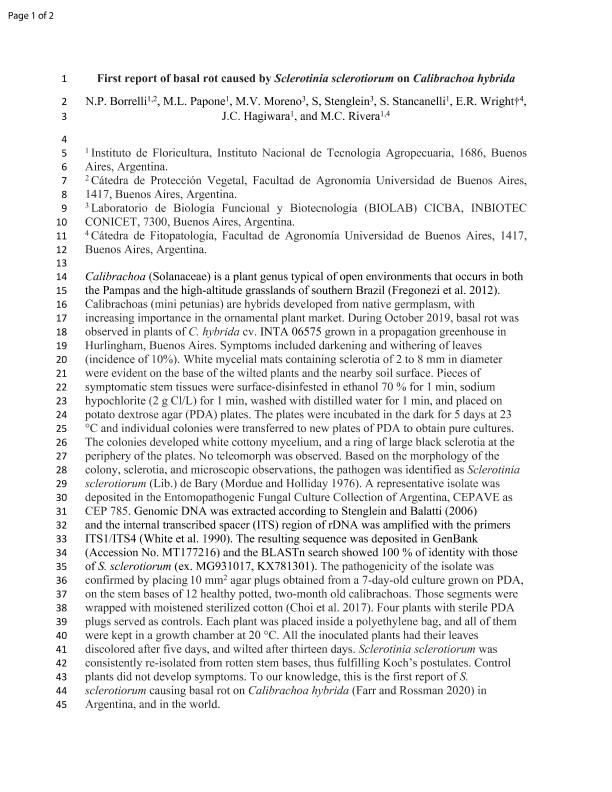Mostrar el registro sencillo del ítem
dc.contributor.author
Borrelli, Nicolas Pablo

dc.contributor.author
Papone, Mirta
dc.contributor.author
Moreno, Maria Virginia

dc.contributor.author
Stenglein, Sebastian Alberto

dc.contributor.author
Stancanelli, Santiago

dc.contributor.author
Wright, Eduardo Roberto

dc.contributor.author
Hagiwara, Juan Carlos

dc.contributor.author
Rivera, Marta Carolina

dc.date.available
2020-08-06T16:30:39Z
dc.date.issued
2020-07
dc.identifier.citation
Borrelli, Nicolas Pablo; Papone, Mirta; Moreno, Maria Virginia; Stenglein, Sebastian Alberto; Stancanelli, Santiago; et al.; First report of basal rot caused by Sclerotinia sclerotiorum on Calibrachoa hybrida; American Phytopathological Society; Plant Disease; 7-2020; 2 p.
dc.identifier.issn
0191-2917
dc.identifier.uri
http://hdl.handle.net/11336/111047
dc.description.abstract
Calibrachoa (Solanaceae) is a plant genus typical of open environments that occurs in both the Pampas and the high-altitude grasslands of southern Brazil (Fregonezi et al. 2012). Calibrachoas (mini petunias) are hybrids developed from native germplasm, with increasing importance in the ornamental plant market. During October 2019, basal rot was observed in plants of C. hybrida cv. INTA 06575 grown in a propagation greenhouse in Hurlingham, Buenos Aires. Those symptoms caused the darkening and withering of the leaves (incidence of 10 %). White mycelial mats containing sclerotia of 2 to 8 mm in diameter were evident on the base of the wilted plants and the nearby soil surface. Pieces of symptomatic stem tissues were surface-disinfested in ethanol 70% for 1 min, sodium hypochlorite (2 g Cl/L) for 1 min, washed with distilled water for 1 min, and placed on potato dextrose agar (PDA) plates. The plates were incubated in the dark for 5 days at 23°C and individual colonies were transferred to new plates of PDA to obtain pure cultures. The colonies developed white cottony mycelium, and a ring of large black sclerotia at the periphery of the plates. No teleomorph was observed. Based on the morphology of the colony, sclerotia, and microscopic observations, the pathogen was identified as Sclerotinia sclerotiorum (Lib.) de Bary (Mordue and Holliday 1976). A representative isolate was deposited in the Entomopathogenic Fungal Culture Collection of Argentina, CEPAVE as CEP 785. Genomic DNA was extracted and the internal transcribed spacer (ITS) region of rDNA was amplified with the primers ITS1/ITS4 (White et al. 1990). The resulting sequence was deposited in GenBank (Accession No. MT177216) and the BLASTn search showed 100 % of identity with those of S. sclerotiorum (ex. MG931017, KX781301). The pathogenicity of the isolate was confirmed by placing plugs of 10 mm2 obtained from a 7-day-old culture grown on PDA,on the stem bases of 12 healthy potted calibrachoas 2 months old. Those segments were wrapped with moistened sterilized cotton (Choi et al. 2017). Four plants with sterile PDA plugs served as controls. Each plant was placed inside a polyethylene bag, and all of them were kept in a growth chamber at 20°C. All the inoculated plants had their leaves discolored after five days, and wilted after thirteen days. Sclerotinia sclerotiorum was consistently re-isolated from rotten stem bases, thus fulfilling Koch?s postulates. Control plants did not develop symptoms. To our knowledge, this is the first report of S. sclerotiorum causing basal rot on Calibrachoa hybrida (Farr and Rossman 2020) in Argentina, and in the world.
dc.format
application/pdf
dc.language.iso
eng
dc.publisher
American Phytopathological Society

dc.rights
info:eu-repo/semantics/openAccess
dc.rights.uri
https://creativecommons.org/licenses/by-nc-sa/2.5/ar/
dc.subject
CALIBRACHOA
dc.subject
SCLEROTINIA
dc.subject
ORNAMENTAL
dc.subject
DISEASE
dc.subject.classification
Micología

dc.subject.classification
Ciencias Biológicas

dc.subject.classification
CIENCIAS NATURALES Y EXACTAS

dc.title
First report of basal rot caused by Sclerotinia sclerotiorum on Calibrachoa hybrida
dc.type
info:eu-repo/semantics/article
dc.type
info:ar-repo/semantics/artículo
dc.type
info:eu-repo/semantics/publishedVersion
dc.date.updated
2020-08-04T19:36:57Z
dc.journal.pagination
2 p.
dc.journal.pais
Estados Unidos

dc.description.fil
Fil: Borrelli, Nicolas Pablo. Instituto Nacional de Tecnología Agropecuaria. Centro de Investigación de Recursos Naturales. Instituto de Floricultura; Argentina
dc.description.fil
Fil: Papone, Mirta. Instituto Nacional de Tecnología Agropecuaria. Centro de Investigación de Recursos Naturales. Instituto de Floricultura; Argentina
dc.description.fil
Fil: Moreno, Maria Virginia. Consejo Nacional de Investigaciones Científicas y Técnicas. Centro Cientifico Tecnolológico Mar del Plata. Instituto de Investigaciones en Biodiversidad y Biotecnología. Laboratorio de Biología Funcional y Biotecnología; Argentina
dc.description.fil
Fil: Stenglein, Sebastian Alberto. Consejo Nacional de Investigaciones Científicas y Técnicas. Centro Cientifico Tecnolológico Mar del Plata. Instituto de Investigaciones en Biodiversidad y Biotecnología. Laboratorio de Biología Funcional y Biotecnología; Argentina
dc.description.fil
Fil: Stancanelli, Santiago. Instituto Nacional de Tecnología Agropecuaria. Centro de Investigación de Recursos Naturales. Instituto de Floricultura; Argentina
dc.description.fil
Fil: Wright, Eduardo Roberto. Universidad de Buenos Aires. Facultad de Agronomía. Departamento de Producción Vegetal. Cátedra de Fitopatología; Argentina
dc.description.fil
Fil: Hagiwara, Juan Carlos. Instituto Nacional de Tecnología Agropecuaria. Centro de Investigación de Recursos Naturales. Instituto de Floricultura; Argentina
dc.description.fil
Fil: Rivera, Marta Carolina. Universidad de Buenos Aires. Facultad de Agronomía. Departamento de Producción Vegetal; Argentina
dc.journal.title
Plant Disease

dc.relation.alternativeid
info:eu-repo/semantics/altIdentifier/doi/http://dx.doi.org/10.1094/PDIS-04-20-0767-PDN
dc.relation.alternativeid
info:eu-repo/semantics/altIdentifier/url/https://apsjournals.apsnet.org/doi/10.1094/PDIS-04-20-0767-PDN
Archivos asociados
